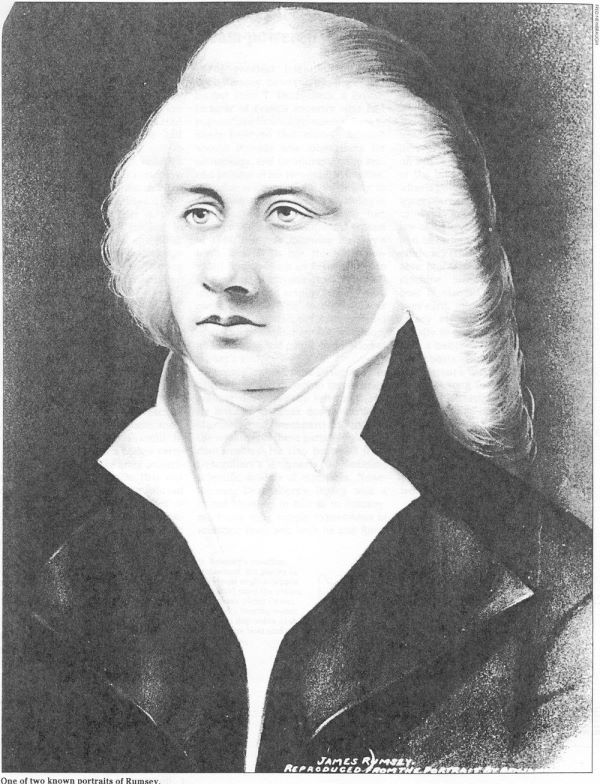In 1787, American engineer James Rumsey demonstrated before a crowd of local notables a peculiar boat on the Potomac River at Shepherdstown in present-day West Virginia. The boat was propelled by a steam engine, but the power of the steam did not turn any propellers nor any paddlewheel. Instead, it sucked water from near the keel, or the bottom of the boat, and ejected it at the stern to move the boat forward. Rumsey’s boat was an early example of jet propulsion, but it would be nearly two centuries before the first practical jetboat would be invented.

A replica of James Rumsey’s steamboat at the Rumsey Steamboat Museum at Shepherdstown. Photo: Historic Shepherdstown & Museum
James Rumsey was born in 1743 in Maryland. His father was a farmer of good social standing, and although his means were limited, Rumsey’s father ensured that his sons got good education. Rumsey served as a soldier during the Revolutionary War, and after the war ended in 1783, he became a partner in a mercantile business. He also kept a boarding house and tavern in Bath, Virginia.
Rumsey was a man of many passions, and one of his interests was to design a boat that moved by mechanical means. Rumsey got his opportunity in 1784, when President George Washington came to visit Bath and stayed at his inn. While there, Rumsey showed Washington a working model of a mechanical boat which he had designed. Rumsey’s design consisted of a paddlewheel mounted at the bow that worked poles to pull the boat upstream. Washington was impressed at Rumsey’s demonstration. He wrote in his diary, September 6, 1784, ‘‘The model and its operation upon the water . . . not only convinced me of what I before thought . . . quite impractical, but that it might be turned to the greatest possible utility in inland navigation.’’

James Rumsey
Washington wrote a certificate of commendation for Rumsey, and using this certificate, Rumsey obtained a patent from the Virginia legislature for "the use of mechanical boats of his model" and also gained an investor. Rumsey was also appointed the superintendent of the newly formed Patowmack Company that was created in 1785 to make the Potomac River navigable for commerce.
For over a year, Rumsey was kept occupied by work at the river, while his brother-in-law Joseph Barnes built the boat around Shepherdstown. Work on the Potomac River was labor-intensive, involving challenging blasting work. Rumsey was responsible for overseeing a large group of workers, which included leased slaves and bondsmen. They were located in a remote area and faced challenges with inadequate supplies.
Eventually, Rumsey resigned from the company so that he could work on his boat. By spring of 1786, the boat was complete, but the test proved unsatisfactory. The pole-boat mechanism caused the boat to yaw in the current, which disabled the paddlewheel and stopped the boat. The boiler was also inadequate and the engine consumed too much steam.
Rumsey decided to abandon the pole-boat mechanism. For a better boiler, Rumsey tried a coil of forged iron pipe, which proved to be both much more efficient and much smaller and lighter. But still, the single-cylinder pump would draw several gallons of water from beneath the boat and send it down a copper pipe to the stern. Because gallons of water were being drawn into the pump at the same time as water was still flowing from it to the stern, the pump was working against itself. This was resolved by replacing the copper pipe with a square wooden trunk with flapper valves in the bottom to allow water in from the river, to relieve the negative pressure at the pump.


Image credit: jamesrumsey.org
Finally, on December 3, 1787, after more than two years of work, Rumsey was able to demonstrate his creation on the Potomac at Shepherdstown. The boat was about 50 feet long and carried 2 tons of rocks and eight women passengers to prove its river-worthiness. The steamboat chugged up the river for about a half mile at the speed of about 4 knots, then turned around and headed back to town, to the witness of the cheering audience. General Horatio Gates, former commander of the Continental Army, famously cried, ‘‘My God, she moves.”
After the successful demonstration, Rumsey took his plans to Philadelphia in search of financial backers. There he found the support of Benjamin Franklin and few others, and together they founded the Rumseian Society to help advance Rumsey’s steamboat and other inventions. While in England, Rumsey was able to take out four patents for various improvements in steam engines, pumps, boilers as well as mill machinery.
Rumsey built another prototype steamboat in London—this one was 100 foot long. But he did not live to see it run. On December 20, 1792, on the eve of the demonstration of his new steamboat the Columbia Maid, he had just finished delivering a lecture to the Society of Mechanic Arts, when he was suffered a stroke and died the next morning. He was buried in London at Saint Margaret's Church.
In 1797, a James Rumsey Monument, consisting of a 75-foot granite column, was erected in Shepherdstown overlooking the Potomac River.

James Rumsey Monument. Photo: Acroterion/Wikimedia
References:
# Not That You Should Care, But James Rumsey Invented the Steamboat, Joab Jackson
# Letters of James Rumsey, Inventor of the Steamboat, Wythepedia












Comments
Post a Comment